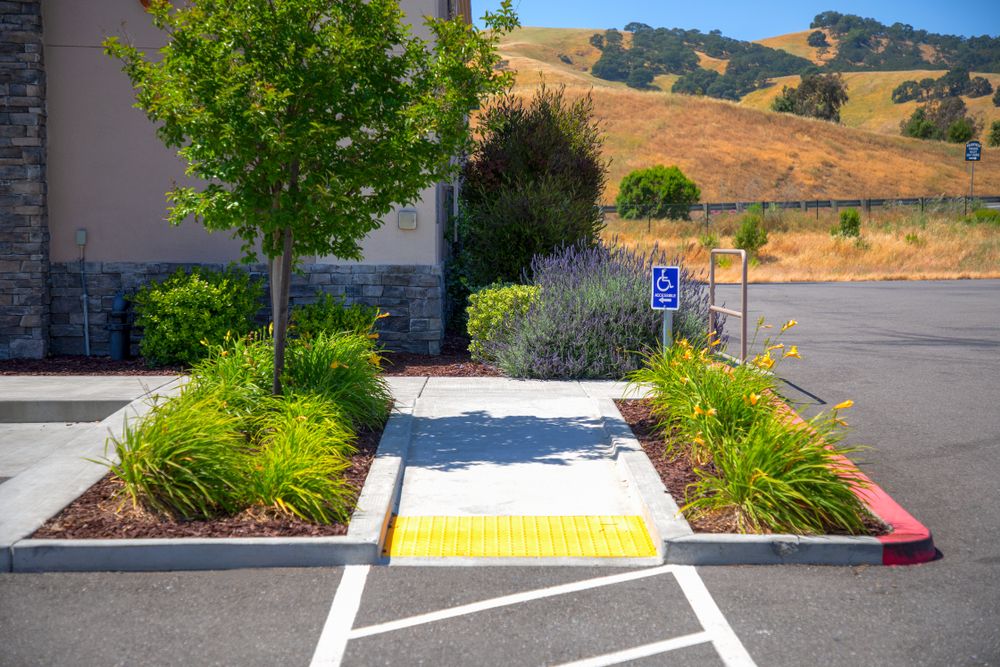
This entry is part 17 of 17 in the series Slips, Trips & FallsSlips, Trips & FallsFloor Safety Basics: Floor Mat Placement Procedures & MaintenanceStep-by-Step: How to Clean Up Spills in the WorkplaceHow to Reduce Parking Lot AccidentsThe Importance of Proper Restaurant Grease Removal for Kitchen FloorsSlip and Fall Accidents: What are floor audits and how can Society help you?Wet Floor Signs: Tips & RegulationsReduce Slips and Falls at Your Grocery or Convenience StoreSlip & Trip Employee Safety Education with a SmileSlip and Fall Claims from a Liability PerspectiveTaking Control of Slip and Fall RisksA Slippery Situation: Cleaning Restaurant Kitchen FloorsSlip-Resistant Shoes for EmployeesFalls Are Not FunnyPrevent Slips and Falls with a Floor Mat ProgramPreventing Summer Slips, Trips and FallsSlips, Trips and Falls Safety TipsKey Considerations for Handicap Ramps & Minimizing Parking Lot Accidents The Americans with Disabilities Act (ADA) has requirements to make public areas accessible to people using wheelchairs, walkers and motorized scooters through the use of ramps.Without ADA approved handicap ramps people with disabilities would have an increased risk of falling from a wheelchair or scooter or tripping while using a walker when going over an elevated curb.In addition, restricting access in public areas under federal law could be construed as a form of discrimination against such individuals.
Therefore, handicap ramps must be installed in accordance with ADA standards. Handicap Ramp Regulations Handicap ramps must be properly sloped based on the height and length of the ramp.Ramps with curbs or side flares should have the edge painted with a contrasting color to give warning of the change in slope and elevation which will help prevent a trip and fall injury.According to the United States Access Board, “Ramps and curb ramps are required along accessible routes to span changes in level greater than ½”.
Elevators and, under certain specified conditions, platform lifts, can be used as an alternative.Portions of accessible routes with running slopes steeper than 5% also must be treated as ramps.” Tactile Raised Dome Warning System In some instances, handicap ramps may be required by law to have a detectable “Tactile Raised Dome” warning system so that those who are visually impaired can feel where they are when using the ramp.There are also regulations that require the painted area of the ramp or walkway to include an abrasive additive or cross-cut grooving to render the surface slip-resistant where wet conditions may be reasonably foreseeable.
Parking Lot Accidents Are on the Rise Parking lots have a variety of hazards to look out for—requiring both pedestrians and vehicles to coexist in close proximity to one another.Additional distractions range from children and mobile devices to digital advertising signage specifically engineered to capture your attention.Parking lots are also the third most frequented place where violent crime occurs and according to the National Safety Council (NSC) over 500 deaths and 60,000 injuries occur in parking lots and that number is on the rise.
There are several things that can be done depending on your specific situation to help minimize hazards in this environment; however, here are 7 tips to help make your parking lot safer.7 Tips to Minimize Parking Lot Accidents Provide drivers and pedestrians with reasonable access pathways such as signs and pavement markings for proper guidance throughout the parking lot.The overall design of the parking lot should be to minimize conflicts, control vehicle speeds and promote proper traffic patterns.Maintain the facility by immediately replacing burned-out light bulbs, repair deteriorated pavement, re-paint worn parking lines, remove ice and snow, and keep vegetation cut low and thin.Use ample lighting near stairwells, elevators, exterior areas of the parking lot or garage, and any location where attackers could hide.Manage access by installing booths or gates.Maintain working video surveillance or CCTV system to maximize visibility throughout the area.Have emergency phones and panic buttons available to enable people to get help quickly when needed.Read, ‘How to Reduce Parking Lot Accidents.’ Watch Webinar on Reducing Outdoor Slip, Trip, and Falls Reducing Risks Associated with Parking Lots In summary, although keeping your parking lot, ramps and walkways completely safe and properly maintained may be challenging, there are things that can be done to minimize this risk to others and in the end will help isolate you from injury and damage claims that will inevitably hurt your bottom line.Consider this 5-step program for reducing the number of falls and establishing defenses if a claim is presented.
To learn more about the big difference Society can make for your business, contact your local independent agent.Series Navigation<< Slips, Trips and Falls Safety TipsShare this post:FacebookTwitterLinkedinemail
Publisher: Society Insurance








